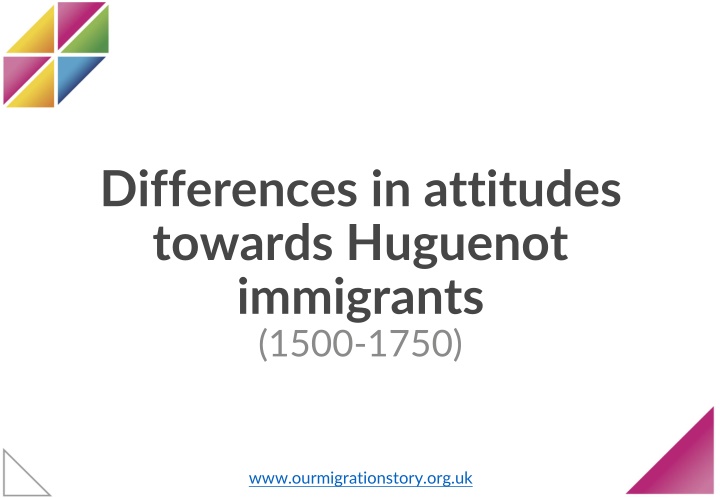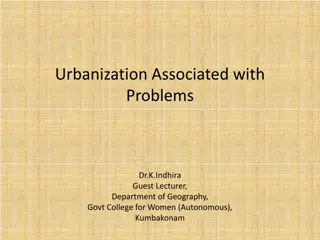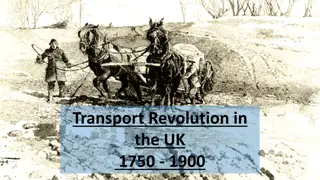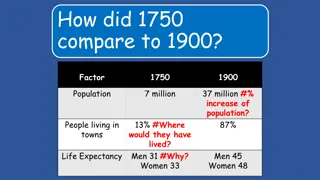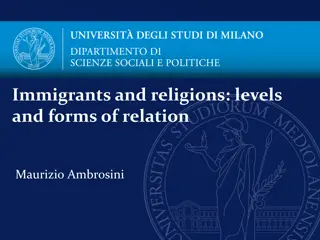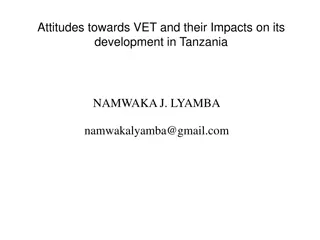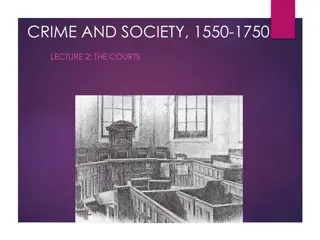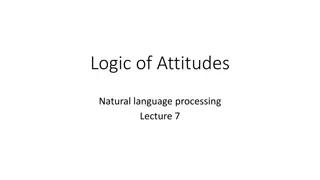Attitudes Towards Huguenot Immigrants (1500-1750)
Differing attitudes towards Huguenot immigrants in Britain from 1500 to 1750. Discover reasons for their migration, reception in Europe, impact on industries, and more through historical sources such as advertisements and academic texts.
Download Presentation

Please find below an Image/Link to download the presentation.
The content on the website is provided AS IS for your information and personal use only. It may not be sold, licensed, or shared on other websites without obtaining consent from the author.If you encounter any issues during the download, it is possible that the publisher has removed the file from their server.
You are allowed to download the files provided on this website for personal or commercial use, subject to the condition that they are used lawfully. All files are the property of their respective owners.
The content on the website is provided AS IS for your information and personal use only. It may not be sold, licensed, or shared on other websites without obtaining consent from the author.
E N D
Presentation Transcript
Differences in attitudes towards Huguenot immigrants (1500-1750) www.ourmigrationstory.org.uk
Attitudes to Huguenot migration Starter task Lesson Objectives To know when and why Huguenot immigrants came to Britain Using two sources, say what we can learn about attitudes towards them To explain why the sources show differing attitudes towards Huguenots in Britain List arguments you have heard for and against immigration During the lesson, compare them to the arguments you hear for and against the immigration of the Huguenots www.ourmigrationstory.org.uk
Attitudes to Huguenot migration Questions based on Huguenot immigration to Britain 1. Which event prompted the first group of Huguenots to come to Britain in the 16th century? 2. Why does the text suggest they came to Britain? 3. Why does the text refer to the Huguenots as refugees? 4. What caused the second large movement of Huguenots to Britain in the late 17th century? 5. Approximately how many Huguenots came to Britain at this time? (be careful!) 6. According to the text: a) In what circumstances did the Huguenots receive a positive reception across Europe? b) In what circumstances did the Huguenots experience a negative reception? 7. Name 5 industries in which Huguenots excelled in Britain. 8. What three reasons does the text give in support of its argument that the Huguenots made a broader impact than any other refugee groups in this period? www.ourmigrationstory.org.uk
The plight of the Huguenots: Thomas Papillon's Advertisement This Advertisement was printed in 1683. It would have been circulated around London and attached to noticeboards in prominent places. It records the significance of a recognisable poor community of French Huguenot refugees who were distinct from richer Huguenot merchants who were already established in England, like the Advertisement s sponsor Thomas Papillon (1623- 1702). The source offers an interesting and important insight into how earlier (in this case much smaller) communities of migrants would assist later arrivals. Courtesy of Corpus Christi College, Oxford www.ourmigrationstory.org.uk
The plight of the Huguenots: Thomas Papillon's Advertisement Origin when was this source produced and by whom? How does this potentially affect its use as a source? What can we learn from the source/what is its message? Purpose why was this source produced at this time? Courtesy of Corpus Christi College, Oxford www.ourmigrationstory.org.uk
Huguenot silk weavers in Spitalfields Published in 1709 by the Booksellers of London and Westminster and sold for 2d, Canary-birds naturaliz din Utopia. A canto was intended to manipulate public opinion against the Bill for the Naturalization of Foreign Protestants, which was going through Parliament that year. The title was inspired by the canaries that the Huguenot silk weavers of Spitalfields kept in bird cages besides their looms to entertain them while they worked. From 1681 Huguenot refugees to Britain could obtain a patent of denization, which brought with it the right to own property. Naturalisation, which brought additional rights of inheritance, was possible by private Act of Parliament, but it was expensive. A private bill could cost 50 or 60. Despite strong native opposition, an Act of General Naturalisation was passed in 1709, but was soon repealed. www.ourmigrationstory.org.uk
Huguenot silk weavers in Spitalfields Origin when was this source produced and by whom? How does this potentially affect its use as a source? What can we learn from the source/what is its message? Purpose why was this source produced at this time? www.ourmigrationstory.org.uk
Attitude shown towards Huguenots in each source: Source A Source B Description of these differences in the sources How these explain the difference in attitudes Reasons for the difference in attitudes The sources have different purposes The sources were produced by different people The sources were written at different times www.ourmigrationstory.org.uk
